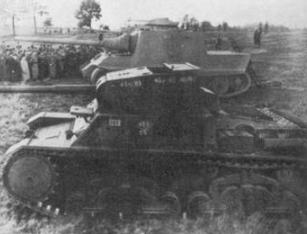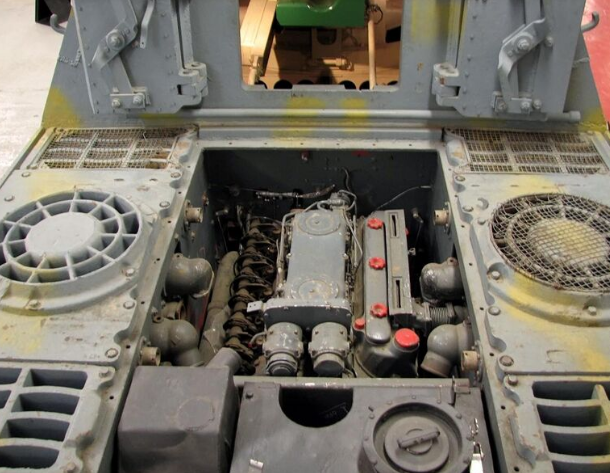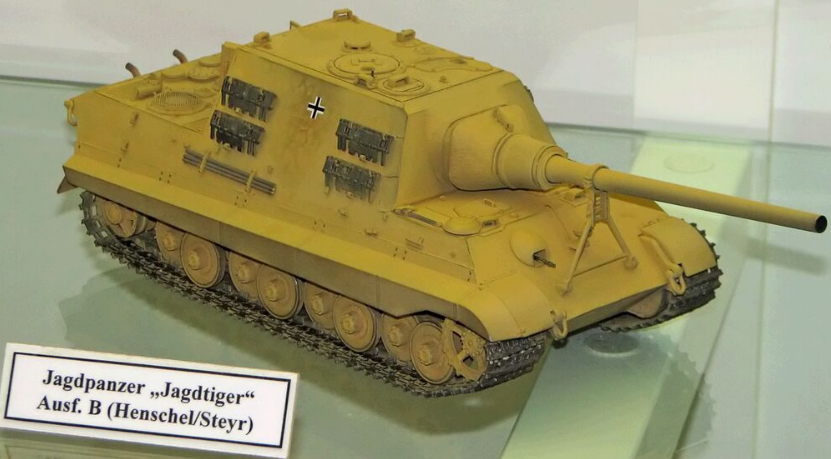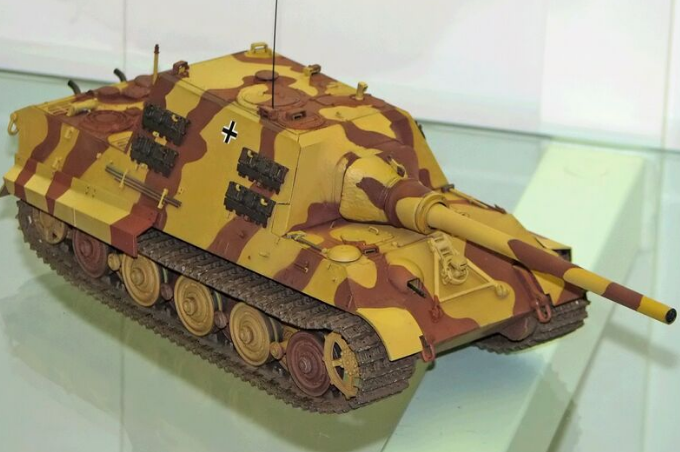
| Version | Summary | Created by | Modification | Content Size | Created at | Operation |
|---|---|---|---|---|---|---|
| 1 | Jason Zhu | -- | 2212 | 2022-10-17 01:35:24 |
Video Upload Options
The Jagdtiger ("Hunting Tiger"; officially designated Panzerjäger Tiger Ausf. B) is a German casemate-type heavy tank destroyer from World War II. It was built upon the slightly lengthened chassis of a Tiger II. Its ordnance inventory designation was Sd.Kfz. 186. The 71-tonne Jagdtiger was the heaviest armored fighting vehicle (AFV) used operationally by any participant nation of WWII and is the heaviest combat vehicle of any type to achieve series production during the conflict. The vehicle was armed with a 128 mm Pak 44 L/55 main gun which was capable of outranging and defeating any tank or AFV fielded by the Allied forces. It saw brief service in small numbers from late 1944 up until the end of the war on both the Western and Eastern Front. Although 150 were ordered, only around eighty were produced. Due to an excessive weight and a significantly underpowered drivetrain system, the Jagdtiger was continuously plagued with various mobility and mechanical problems. At present, three Jagdtigers survive in different museums around the world.
1. Development
With the success of the StuG III, Marder I, Marder II, and Marder III in the tank destroyer role, the military leadership of Nazi Germany decided to use the chassis of existing armored fighting vehicles as the basis for self-propelled guns (serving as assault guns and tank destroyers). German tank destroyers of World War II used fixed casemates instead of fully rotatable turrets to significantly reduce the cost, weight, and materials necessary for mounting large-caliber guns.

In early 1942, a request was made by the Army General Staff to mount a 128 mm gun on a self-propelled armored chassis. Firing tests of the 128 mm gun showed it to have a high percentage of hits; smaller caliber guns, such as the ubiquitous 88 mm and the slightly larger 105 mm, were also tested.[1]
By early 1943, a decision was made to install a 128 mm gun on either a Panther or Tiger I chassis as a heavy assault gun. The Panther chassis was considered unsuitable after a wooden mockup of the design was constructed. On 20 October 1943, another wooden mockup was constructed on a Tiger II chassis, and presented to Hitler in East Prussia. Two prototypes were produced: One was a version fitted with the eight-roadwheel Porsche suspension system (Serial Number 305001) and another version was equipped with the Henschel nine-overlapping roadwheel suspension system (Serial Number 305002),[2] as used on the main-production Tiger IIs constructed by Henschel. They were completed in February 1944. It was originally designated as Jagdpanzer VI but was later renamed as the Jagdtiger[3] and received the Sd.Kfz. 186 designation as its inventory ordnance number.
2. Design

The Jagdtiger was a logical extension of the creation of Jagdpanzer designs from tank designs, such as the Jagdpanzer IV or the Jagdpanther from the Panzer IV and Panther tanks respectively, with a fully armored and enclosed casemate-style fighting compartment. The Jagdtiger used a boxy superstructure, with its sides integral with the hull sides, on top of a lengthened Tiger II chassis. Unlike the Jagdpanther, the Jagdtiger's casemate design did not extend its glacis plate upwards in one piece to the full height of the casemate's "roof" - it used a separate forward plate to form its casemate structure atop the hull roof, and mount its anti-tank gun. The resulting vehicle featured very heavy armor. It had 250 mm (9.8 in) armor on the front of the casemate and 150 mm (5.9 in) on the glacis plate. The main gun mount had a limited traverse of only 10 degrees; the entire vehicle had to be turned to aim outside that narrow field of fire.
The Jagdtiger suffered from a variety of mechanical and technical problems due to its immense weight and under-powered engine. The vehicle had frequent breakdowns; ultimately more Jagdtigers were lost to mechanical problems or lack of fuel than to enemy action.[1]
3. Production


One hundred and fifty Jagdtigers were initially ordered[4] but only between 70[5] and 85 were produced at the Nibelungenwerk at St. Valentin, from July 1944 to May 1945. Eleven of them, serial numbers 305001 and 305003 to 305012, were produced with the Porsche suspension (with eight road wheels per side); all the rest used the Henschel suspension with nine road wheels per side.
Important parts such as the tub, superstructure and drive wheels were supplied by the Eisenwerke Oberdonau.[6] Details and production locations were known to the Allies through the resistance group around the later executed priest Heinrich Maier.[7][8][9] Prisoners from the St. Valentin concentration camp were used to build the tank.[10]
Production figures vary depending on source and other factors such as if prototypes are included and if those made after VE day are included: approximately 48 from July 1944 to the end of December 1944; 36 from January to April 1945, serial numbers from 305001 to 305088.
| Date | Number produced |
Serial # |
|---|---|---|
| February 1944 | 2 | 305001–305002 |
| July 1944 | 3 | 305003–305005 |
| August 1944 | 3 | 305006–305008 |
| September 1944 | 8 | 305009–305016 |
| October 1944 | 9 | 305017–305025 |
| November 1944 | 6 | 305026–305031 |
| December 1944 | 20 | 305032–305051 |
| January 1945 | 10 | 305052–305061 |
| February 1945 | 13 | 305062–305074 |
| March 1945 | 3 | 305075–305077 |
| April 1945 | 7 | 305078–305084 |
| May 1945 | 4 | 305085–305088 |
After serial number 305011 (September 1944), no Zimmerit anti-magnetic paste was factory applied.
4. Combat History
Only two heavy anti-tank battalions (schwere Panzerjäger-Abteilung), numbered the 512th and 653rd, were equipped with Jagdtigers, with the first vehicles reaching the units in September 1944. About 20% were lost in combat, with most destroyed by their own crews when abandoned, chiefly due to various mechanical breakdowns or the chronic lack of fuel in the final stages of the war.
The gun used two-part ammunition, which meant that the main projectile and the cased propellant-charge were loaded into the gun-breech separately. Two loaders were tasked with this work, one for each type.
Tiger I tank ace Otto Carius commanded the second of three companies of Jagdtigers in schwere-Panzerjäger Abteilung 512. His postwar memoir Tigers in the Mud provides a rare combat history of the 10 Jagdtigers put under his command. He states that the Jagdtigers were not utilized to their full potential due to several factors, among them that Allied air supremacy made it difficult to maneuver around and the massive heavy gun needed to be re-calibrated from jarring after travelling off-road for even short distances.[11][12] The vehicle was slow, having been equipped with the same engine as the already-underpowered Tiger I and Tiger II, and the vehicle's transmissions and differentials broke down easily because the whole 72-tonne vehicle needed to rotate for the gun's traverse. The enormous 128mm main-gun had to be locked down during the vehicle's maneuvers, otherwise its mounting-brackets would have worn out too much for accurate firing afterwards. As such, a crew-member had to exit the vehicle in combat and unlock the gun from its frontally mounted gun travel-lock before firing.[13] According to Carius, in combat, he recorded that a 128 mm projectile went through the walls of a house and destroyed an American tank behind it.[14]
Insufficient training of vehicle crews and their poor morale during the last stage of the war were the biggest problems for Jagdtiger crewmen under Carius's command. At the Ruhr Pocket, two Jagdtiger commanders failed to attack an American armored column about 1.5 km (1 mile) away in broad daylight for fear of attracting an Allied air attack, even though the Jagdtigers were well-camouflaged.[15] Both vehicles broke down while hurriedly withdrawing through fear of the supposed air attack that did not materialize and one was then subsequently destroyed by its crew. To prevent such a disaster, at Siegen, Carius himself dug in his command vehicle on high ground. An approaching American armored column avoided his prepared ambush because nearby German civilians warned them of it.[16] Later, one of his vehicles fell into a bomb crater at night and was disabled while another was lost to a Panzerfaust attack by friendly Volkssturm militia troops who never saw a Jagdtiger before and possibly misidentified it as an Allied armored vehicle.[14]
The first Jagdtiger lost in combat was during the failed Operation Nordwind offensive in France in 1945. Rather embarrassingly for what was the most heavily armored vehicle to serve in World War Two, this particular Jagdtiger was lost not to combat with other armored vehicles or aircraft but by American infantry using a bazooka, which at the time was considered an underpowered and ineffective weapon to counter such a massive vehicle.[17]
Near Unna, one Jagdtiger climbed a hill to attack five American tanks 600 meters away, leading to two withdrawing and the other three opening fire. The Jagdtiger took several hits but none of the American projectiles could penetrate the 250 mm (9.8 in) thick frontal armor of the vehicle's casemate. However, the inexperienced German commander then lost his nerve and turned around instead of backing down, thus exposing the thinner side armor, which was eventually penetrated and all six crew members were lost. Carius wrote that it was useless when the crews were not trained or experienced enough to have the thick frontal armor facing the enemy at all times, if possible, in combat.[18]
When unable to escape the Ruhr Pocket, Carius ordered the guns of the remaining Jagdtigers destroyed (to prevent intact vehicles falling into Allied hands) and then surrendered to American forces.[19] The 10 Jagdtigers of the 2nd Company of Panzerjagerabteilung 512 destroyed one American tank for one Jagdtiger lost to combat, one lost to friendly fire, and eight others lost to mechanical breakdown or destruction by their own crews to prevent capture by enemy forces.
On 17 January 1945, two Jagdtigers used by the Wehrmacht's XIV Corps engaged a bunker-line in support of assaulting infantry near Auenheim. On 18 January, they attacked four secure bunkers at a range of 1,000 meters. The armored cupola of one bunker burned out after two shots. A Sherman attacking in a counter-thrust fight was set afire by explosive shells. The total combat saw the usage by the two vehicles of 46 explosive shells and 10 anti-tank shells, with no losses to the Jagdtigers.
In April 1945, s.Pz.Jäg.Abt.512 saw a great deal of action, especially on 9 April, where the 1st Company engaged an Allied column of Sherman tanks and trucks from hull-down positions and destroyed 11 tanks and over 30 unarmored or lightly armored targets, with some of the enemy tanks having been knocked out from a distance of more than 4,000 m. The combat unit only lost one Jagdtiger in this incident, after Allied ground-attack P-47 fighters appeared. During the next couple of days, the 1st Company destroyed a further five Sherman tanks before having to surrender to US troops at Iserlohn. Meanwhile, the 2nd Company still fought on but with little results gained. On 15 April 1945, the unit surrendered at Schillerplatz in Iserlohn.[20]
5. Survivors
Three Jagdtigers survive in museums around the world, one each in the US, the UK and Russia:
- Jagdtiger (serial number 305004): The Tank Museum in England . One of the 11 Porsche–designed suspension-equipped variants, it was captured by British troops in April 1945 near the armour proving ground at Sennelager, Germany, where it was undergoing testing and trials.[21] The third wheel-station (paired-wheel bogie) on the left side is missing. Zimmerit was applied to approximately 2 meters high on the superstructure and the German Balkenkreuz was painted in the mid-section of the vehicle's casemate's side. The earlier 18-tooth drive-sprocket version is found on this vehicle (later vehicles had 9-tooth drive sprockets).
- Jagdtiger (serial number 305020): National Armor & Cavalry Museum in Fort Benning, Georgia. It was produced in October 1944 and was attached to the 3rd Company of the s.Pz.Jg.Abt 653, bearing the vehicle-number of 331. It was captured by American troops near Neustadt an der Weinstraße, Germany in March 1945. Shell damage is still visible on the gun mantlet, glacis plate and lower-nose armor. This vehicle used the later-version nine-tooth drive sprockets[22] for use with the 'contact shoe' and 'connector link'-style continuous track it shared with the Tiger II on which it was based.
- Jagdtiger (serial number 305083): Kubinka Tank Museum near Moscow. This vehicle, equipped with the standard Henschel-built running gear, was acquired by Soviet forces when a Kampfgruppe (battle-group) of the s.Pz.Jg.Abt 653 equipped with four Jagdtigers surrendered to the Red Army in Amstetten, Austria on 5 May 1945. This Jagdtiger, not coated with Zimmerit, was acquired in mint condition with complete sideskirts and the later nine-tooth drive sprockets. Twelve hooks on both sides of the superstructure were designed to carry six pairs of track-links (all spare tracks on either side missing on this vehicle). All of the Jagdtiger's repair-tools are also missing, but it still retains the MG 42 anti-aircraft gun mount on the rear engine-deck (recent photographs show that this specific machine gun-mount has since been removed, leaving only its mounting-base).[22]
6. Variants
Aside from the 11 early vehicles with a Porsche suspension, the only variant developed was the Sd.Kfz.185.
- 8.8 cm PaK 43 Jagdtiger - The difference was that the gun used was the 8.8 cm Pak 43 rather than the 12.8 cm Pak 44. This was due to shortages of the latter weapon. The variant did not enter production .[23]
References
- Schneider (1990)
- Ledwoch
- Achtung Panzer! - Jagdtiger http://www.achtungpanzer.com/pz12.htm
- Chamberlain & Doyle (1999), p. 144
- Bishop (2002), p. 48.
- Eisenwerke Oberdonau - Linz http://www.geheimprojekte.at/firma_rhg_eisenwerke_linz.html
- Peter Broucek "Die österreichische Identität im Widerstand 1938–1945" (2008), p 163.
- Hansjakob Stehle: Die Spione aus dem Pfarrhaus. In: Die Zeit. 5 January 1996.
- Pirker 2012, p. 252.
- KZ-Außenlager St. Valentin https://www.mauthausen-guides.at/aussenlager/kz-aussenlager-st-valentin
- Carius (2003), p. 208
- This particular problem was attributed more to the eight wheel Porsche type suspension, which proved unfit for off-road terrain, causing excessive vibrations that, over a short period, could throw the gun out of calibration. The improved nine-wheel Henschel type suspension system from the King Tiger was thought to have suffered less from this particular problem. It is unknown which type was fitted to the Jagdtigers Carius commanded.
- Carius (2003), p. 207
- Carius (2003), p. 214
- Carius (2003), p. 210
- Carius (2003), p. 212
- Wiley, David. "Tank Chats: Jagdtiger". The Tank Museum. https://www.youtube.com/watch?v=xv9QAXPJVSc&t=889s.
- Carius (2003), p. 221
- Carius (2003), p. 224
- Devey (1999)
- Bovington Tank Museum accession record http://www.tankmuseum.org/ixbin/indexplus?_IXSS_=_IXMENU_%3d%26ALL%3djagdtiger%26_IXACTION_%3dsummary%26%252asform%3d%252fsearch_form%252fbovtm_combined%26TYPE%3darticle%26_IXFPFX_%3dtemplates%252fsummary%252f&_IXFIRST_=2&_IXSPFX_=templates/full/tvod/t&_IXMAXHITS_=1&submit-button=summary&_IXSESSION_=&_IXMENU_=Vehicles
- Duske, Greenland & Schulz (1996)
- Chamberlain & Doyle (1999), pp. 144, 246, 249




